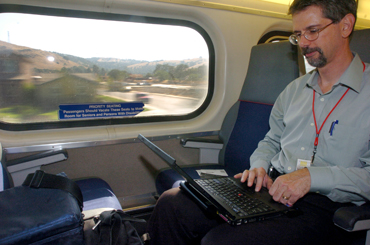
But yet again, the Gilroy to San Jose line is not included in
the planning process
South Santa Clara and San Benito county commuters who ride
Caltrain will benefit to varying degrees when the train rolls out
free high-speed wireless Internet service within a year. That is if
they stay on the train long enough.
But yet again, the Gilroy to San Jose line is not included in the planning process
South Santa Clara and San Benito county commuters who ride Caltrain will benefit to varying degrees when the train rolls out free high-speed wireless Internet service within a year. That is if they stay on the train long enough.
Those with longer commutes will have the option of using free broadband service since Caltrain plans to office the wireless connection to laptop users from the San Jose Diridon Station to the San Francisco station, leaving many south county riders out of luck.
Caltrain demonstrated the new technology for reporters and train riders last week. The train staff has been working with Intel Solution Services and Nomad Digital Ltd., a British company that has already provided portions of the London Underground with wireless Internet.
Many South Valley train commuters – who have commute times varying from 45 minutes up to 2-½ hours – already use the blue commuter seats as a desk away from the office.
Pat Carbondel, who works for a San Francisco architecture firm, has a four-hour round-trip ride when he goes into the office from Gilroy. He spends the two hours before and after his day at the office working on the train.
“It’s part of my work day,” Carbondel said, who has a wireless adapter that allows him to access the Internet from his laptop.
His employer pays for the service, but Carbondel called it a “glorified cell phone” and said it often works as slow as a modem when he tries to save work to a server where it can be accessed by others in the office.
“This is supposed to be near broadband [speed], supposedly,” Carbondel said. “But sometimes it will take 5-10 minutes to save to a server.”
Carbondel, who often shuts his computer down South of Blossom Hill when the tracks get bumpy, said having high speed Internet for most of his commute would be a great benefit for him.
For another rider, the high-speed Internet won’t have an effect because he already has a wireless adapter that works fine for what he needs. Jim Frankfort, a Gilroy resident who works in the healthcare industry, uses his laptop to surf and do research before and after work.
“It can be quite productive,” Frankfort said.
His company offers continuing education online and he has been able to view multimedia files while on the train, such as training videos, slides and audio.
Some commuters, however, will have no access to the new service when it is rolled out in a year. The high-speed wireless Internet is unlikely to be offered south of the Tamien station because Caltrain only owns the right of way on the tracks from Tamien to San Francisco, though at this time the service is expected to be offered only as far south as San Jose Diridon, according to Weinberg.
For the wireless service, radio transmitters need to be installed along the trackside, making it easier for Caltrain to install in the areas where they own the right of way.
Bruce Rideout, a Gilroy resident who boards the train in San Martin, only rides to the Tamien station in south San Jose.
“There are times I could use it,” Rideout said, who sat with a laptop Tuesday afternoon. “I usually have it organized so I can do what I need to do at home or in the office if it requires the Internet.”
In the meantime, Caltrain staff is optimistic the service will be available within a year.
“The demonstration last week was an opportunity to show it off,” Weingberg said.”We had our IT [information technology] staff come out with large screen computers so that we could show it.”
The staff surfed the Internet, downloaded large files and watched streaming video without interruption.
Nomad provided a mobile communication system that links the train to trackside wireless base stations, with radios every few miles along the rail line, to keep the connection seamless. Other companies involved in the trial run included Sensoria, which provided the WiFi access point in each car and Redline Communications, which provided the radio that connects the train to the trackside signal.
The demonstration marked the first time broadband-speed Internet had successfully been used on a rail line traveling up to 79 miles an hour in the United States.
“Caltrain reinvented itself when it introduced faster train service,” said Ken Yeager, Caltrain board chair. “With this cutting edge technology, Caltrain is poised for future success.”
Weinberg could not give an estimated cost for installing the equipment necessary for the new technology, called WiMax, because as a government agency, Caltrain will need to take bids for the equipment and installation.
“It makes the train travel experience more pleasurable and more productive,” Weinberg said. “People can get on the train at 7 in the morning and get an hour’s worth of work done. That’s an hour less they have to spend in the office that day.”









